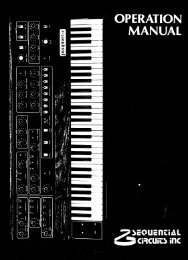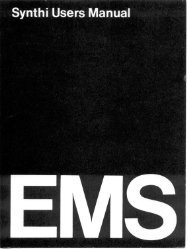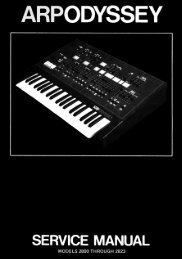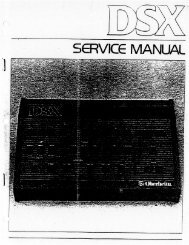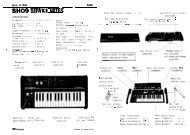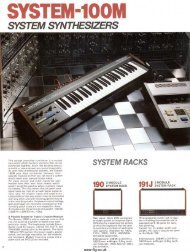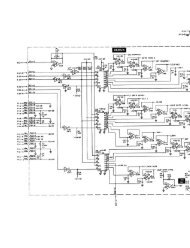ARP2600 - Fundamentals of Music Technology - Cyborgstudio.com
ARP2600 - Fundamentals of Music Technology - Cyborgstudio.com
ARP2600 - Fundamentals of Music Technology - Cyborgstudio.com
Create successful ePaper yourself
Turn your PDF publications into a flip-book with our unique Google optimized e-Paper software.
026 - SECTION THREE: VCO-2VCO-1In LF ModeSaw WaveVCO-2PWM inputFigure 3-11: A basic PWM patchPulseWaveOutputTo amplifierIn this patch, VCO-1 is themodulator, and VCO-2 is thecarrier. The saw signal goingfrom VCO-1 to VCO-2 is acontrol signal, while the pulsewave output <strong>of</strong> VCO-2 is thecarrier signal. Pulse widthmodulation has a very distinctivesound and while it is notwidely used, it is certainly animportant and useful synthesistechnique.DISSECTING THE BASIC PWM PATCHThe basic PWM patch has only four parameters. First, the frequency <strong>of</strong> VCO-1 can be set. This parameteris once again referred to as rate in this patch. Secondly, VCO-1’s waveform can be changed.However, the saw wave is really a more <strong>com</strong>mon choice than the square wave, since the saw wave willproduce a continuous sweep. Third, the in<strong>com</strong>ing control voltage can be attenuated by the fader abovethe PWM input. This parameter will once again be referred to as depth. When too much depth is usedin PWM, it be<strong>com</strong>es hard to perceive a tone. When the depth and rate be<strong>com</strong>e fast enough, once again,sidebands are produced. These sidebands are very similar in sound to those created by FM. Finally,VCO-2’s frequency can be set. VCO-2’s timbre is not a parameter in this patch, since it is not somethingthat can be changed. If one wants to hear PWM, one must use a pulse wave.OTHER POSSIBILITIES WITH TWO OSCILLATORSAnother useful technique available to the experimenter at this time is using both VCO-1 and VCO-2 inaudio mode, and listening to different waveforms from each <strong>of</strong> them at the same time. Patching thesquare output <strong>of</strong> VCO-1 and the saw output <strong>of</strong> VCO-2 to the mixer might sound pretty unpleasant atfirst, but this is merely because the oscillators haven’t been tuned together.In Section 2, the technique for tuning an oscillator to another source was discussed. Now is the time toapply that knowledge. It is important to first decide which oscillator will be the one that will be tunedand which oscillator will be the one that the other is tuned to. For demonstration purposes, VCO-1 willbe the standard by which to tune VCO-2 and that VCO-2 will be the oscillator that will actually betuned.To begin, VCO-1 must be set at a <strong>com</strong>fortable frequency. Next, VCO-2’s frequency must be roughlymatched to VCO-1’s. This is ac<strong>com</strong>plished with the INITIAL FREQUENCY slider. It takes a good earand a steady hand to ac<strong>com</strong>plish this. Once VCO-2 is close to VCO-1, the FINE TUNE slider is used tobring them exactly in tune. As the frequencies get close to matching, ‘beats’ can be heard in the sound.These beats can be a big clue to how close the frequencies are to matching each other. The faster thebeats, the farther the frequencies are from matching. If the FINE TUNE slider is being moved, and the




